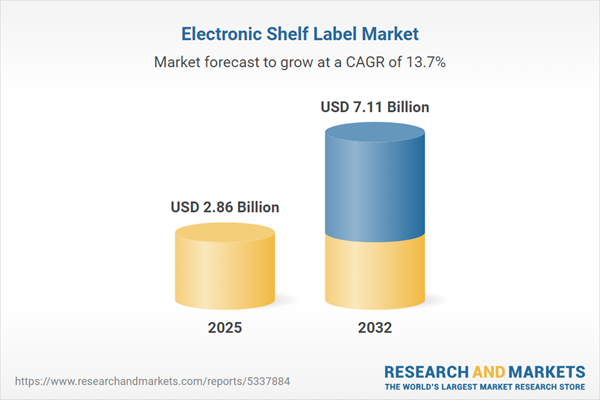Speak directly to the analyst to clarify any post sales queries you may have.
The electronic shelf label market is enabling retailers to modernize in-store operations, enhance pricing agility, and advance inventory management. Senior executives recognize these digital labeling systems as essential for developing agile strategies and maintaining strong store performance as retail dynamics evolve.
Market Snapshot: Electronic Shelf Label Market Growth
The electronic shelf label market is delivering steady year-over-year expansion, highlighted by a robust compound annual growth rate. This sector’s resilience stems from accelerating digital transformation as retailers focus on automating price updates, integrating omnichannel functions, and improving operational transparency. Electronic shelf label adoption strengthens pricing accuracy, supports clear inventory views, and reduces workflow delays among retail staff. Retailers are investing in energy-efficient display solutions and modular systems, enabling adaptability to changing regulations and consumer needs. Within a highly competitive landscape, digital shelf technologies are forming the backbone of organizational responsiveness, helping enterprises optimize workflows and meet emerging performance standards.
Scope & Segmentation of the Electronic Shelf Label Market
This market analysis presents detailed segments and enabling technologies, allowing senior decision-makers to align investments with business goals, prioritize innovation, and address evolving market opportunities. Each segment underpins specific operational priorities and market responsiveness:
- Product Type: E-paper displays emphasize clarity and long-term energy savings. LCD-based formats address specialized operational requirements common in select retail formats.
- Component: Batteries, display modules, microprocessors, and wireless infrastructure form the foundation required for reliable, scalable, enterprise-wide deployments.
- Communication Technology: Infrared, NFC, and radio frequency options enable automatic and secure pricing updates suited for various store sizes and layouts.
- Display Size: Compact labels facilitate precise SKU identification, while larger display units support flexible pricing and impactful promotions at the category level.
- Application: Solutions are deployed across supermarkets, specialty retailers, department stores, and industrial supply environments to support fast pricing adjustments and targeted offers.
- Distribution Channel: Combines traditional offline distribution with modern digital and cloud-based provisioning for both on-site implementation and centralized management.
- Geographic Coverage: Market presence spans North America, Europe, Asia-Pacific, the Middle East, South America, and Africa. Western Europe, China, India, Southeast Asia, Australia, Japan, and GCC countries are especially active in technological innovation, partnership development, and regulatory advancement.
- Company Profiles: Key participants include Displaydata Limited, Hanshow Technology Co., Ltd., Diebold Nixdorf, ADVANTECH AE, Pricer AB, VusionGroup, Epishine AB, and Panasonic Connect Europe GmbH, each offering diverse operational capabilities and supply strengths.
Key Takeaways Influencing Executive Strategy
- Centralized management platforms allow synchronized pricing and promotional changes across stores, reducing rollout complexity and driving operational gains.
- Choosing energy-saving display options helps manage ongoing maintenance costs and aligns with sustainability commitments for corporate social responsibility.
- Advanced high-resolution displays, paired with secure wireless technology, help ensure reliable operations and seamless daily functions as systems scale.
- Cloud connectivity and IoT integration provide rapid, data-driven responses to consumer demands, facilitating intelligent updates to pricing and inventory.
- Supplier diversification and proactive compliance strategies support resilience in supply chain management amid regulatory shifts and market volatility.
Tariff Impact: Navigating Shifting 2025 Trade Policies
Ongoing changes in United States tariff policy are introducing added complexity to procurement and logistics for electronic shelf labels. Executives are reconfiguring supplier networks, turning to regional manufacturing partnerships, and streamlining logistics models to help ensure sourcing continuity. Retailers are also updating their procurement and pricing processes to protect business continuity and compliance as global trade conditions shift.
Primary Research Methodology & Data Sources
This report is based on direct interviews with retail executives, validated secondary source research, and exclusive quantitative analysis. Findings undergo further review through industry expert panels to provide an accurate perspective for executive planning and market readiness.
Why This Report Matters
- Offers impartial benchmarking of technology platforms and supplier performance, supporting informed sourcing, negotiation, and market entry decisions.
- Enables senior leaders to rapidly adjust to changes in tariff policies and regulations, strengthening operational resilience during uncertain business cycles.
- Supports effective digital transformation initiatives and fosters data-driven, reliable supplier relationships throughout the value chain.
Conclusion
Adopting electronic shelf label solutions allows retail leaders to enhance operational efficiency and build a future-ready store environment. Strategic investments help organizations respond to market demands and sustain their competitive advantages over time.
Additional Product Information:
- Purchase of this report includes 1 year online access with quarterly updates.
- This report can be updated on request. Please contact our Customer Experience team using the Ask a Question widget on our website.
Table of Contents
3. Executive Summary
4. Market Overview
7. Cumulative Impact of Artificial Intelligence 2025
List of Figures
Companies Mentioned
The companies profiled in this Electronic Shelf Label market report include:- Displaydata Limited
- Hanshow Technology Co., Ltd.
- ADVANTECH AE
- Diebold Nixdorf, Incorporated
- Epishine AB
- GuangZhou PanPanTech Co., Ltd
- Hangzhou Ontime I.T. Co., Ltd.
- Hangzhou Zkong Network Technology Co., Ltd.
- LANCOM Systems GmbH by Rohde & Schwarz USA, Inc.
- MOKOsmart
- NZ Electronic Shelf Labelling
- Opticon Sensors Europe B.V.
- Panasonic Connect Europe GmbH
- Pricer AB
- Retail Solutions Pro DBA
- S&K Solutions GmbH & Co. KG
- Sen Security Solutions
- VusionGroup
- Shanghai Sunmi Technology Co., Ltd.
- Shenzhen Minew Technologies Co., Ltd.
- Silicon Laboratories, Inc.
- SoluM Europe GmbH
- SureSolutions by Deki Electronics Ltd
- Teraoka Seiko Co., Ltd.
- TroniTAG GmbH
- YalaTech Co., Ltd.
- ZhSunyco
Table Information
| Report Attribute | Details |
|---|---|
| No. of Pages | 183 |
| Published | November 2025 |
| Forecast Period | 2025 - 2032 |
| Estimated Market Value ( USD | $ 2.86 Billion |
| Forecasted Market Value ( USD | $ 7.11 Billion |
| Compound Annual Growth Rate | 13.7% |
| Regions Covered | Global |
| No. of Companies Mentioned | 28 |









